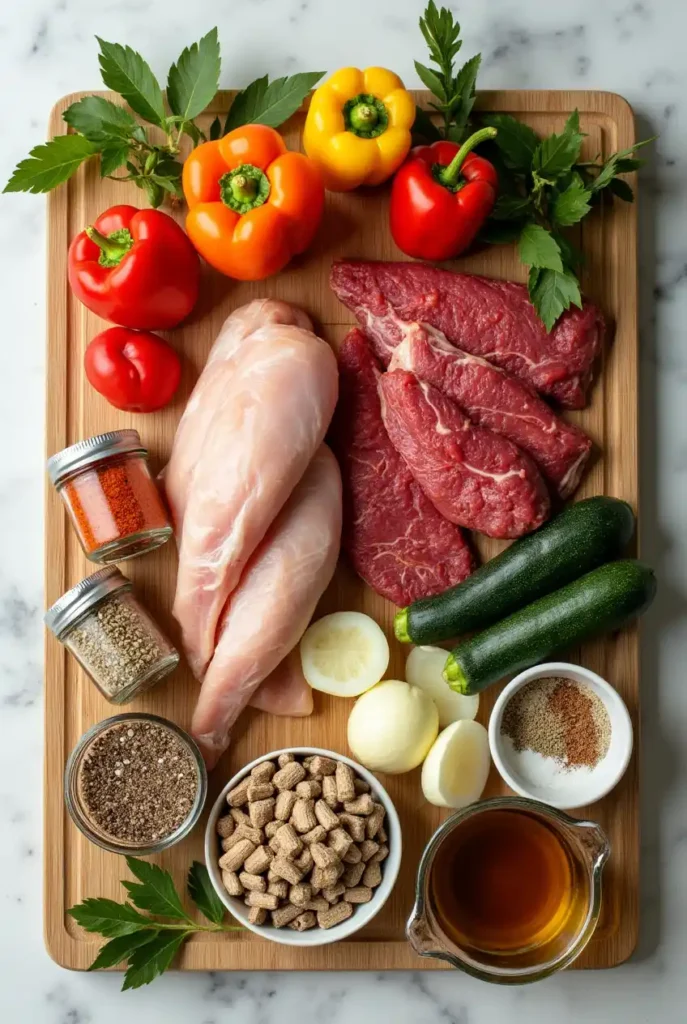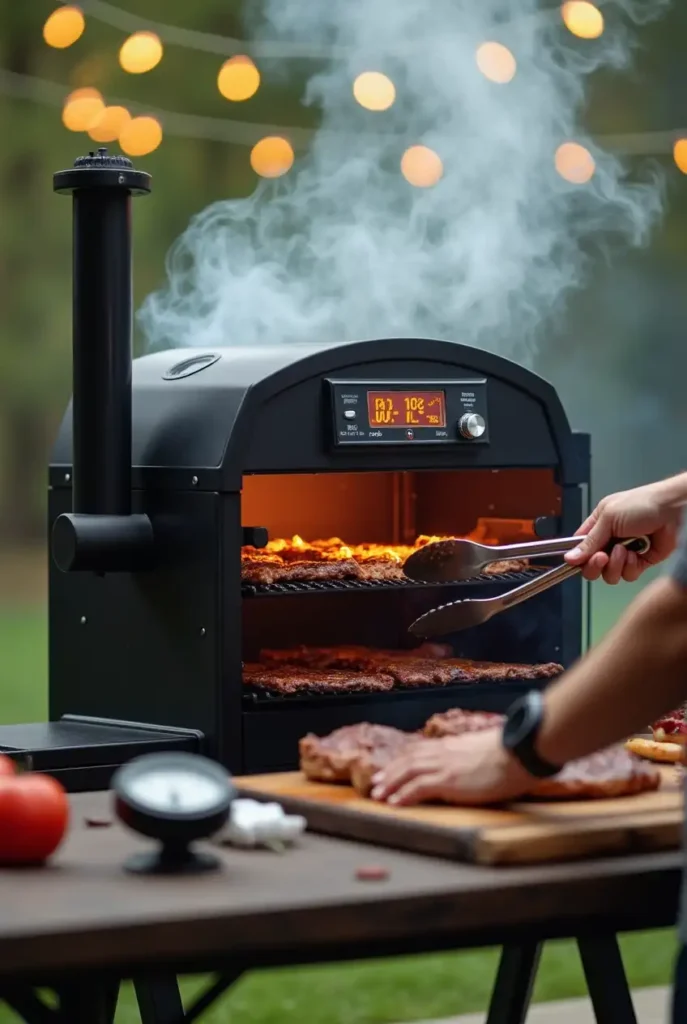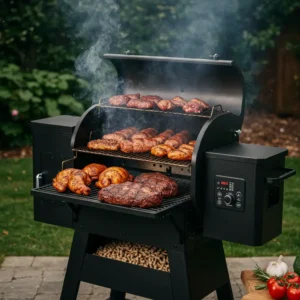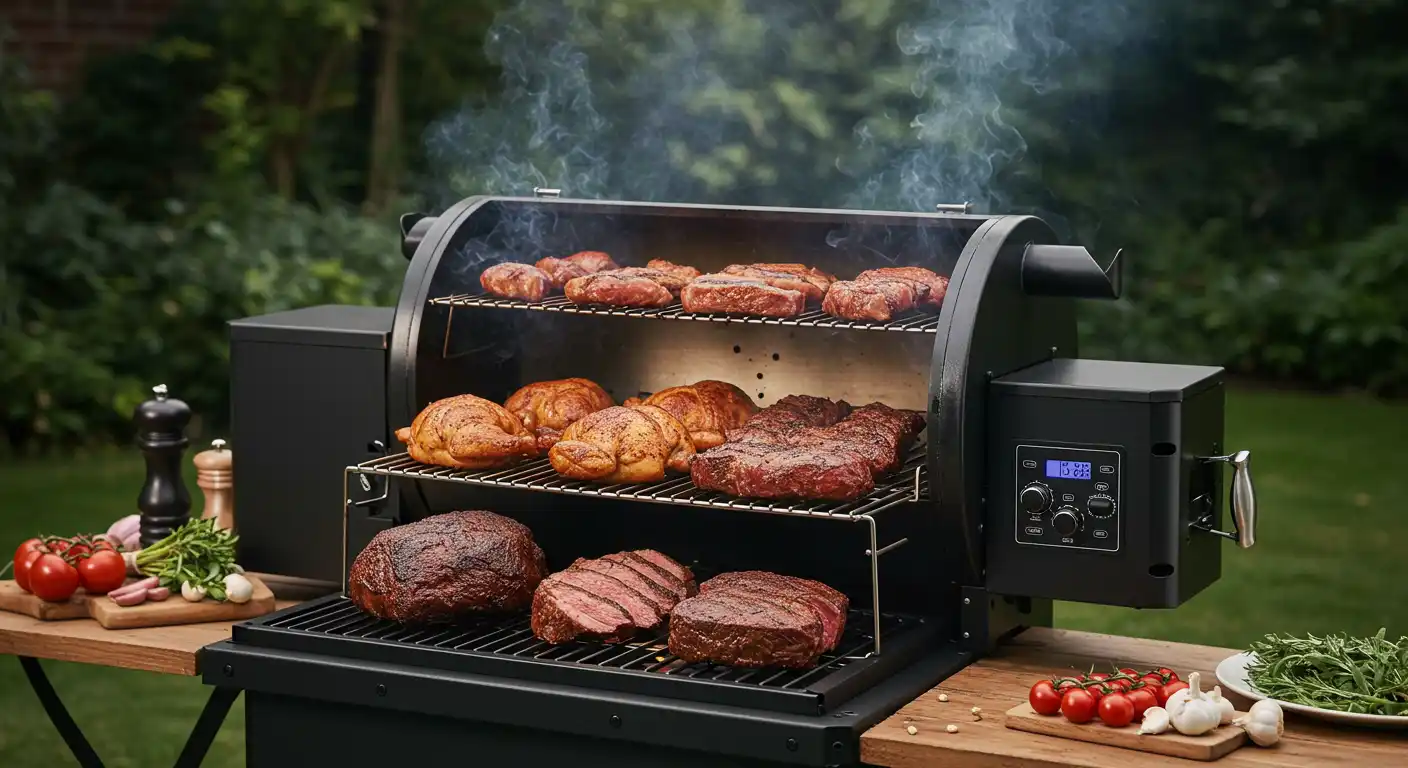Welcome to our pellet smoker recipes guide. Here, you will learn how to cook with a pellet smoker. A pellet smoker burns wood pellets slowly, making food tender and full of smoky flavor.
This guide shows you how to cook meats like chicken, pork, and beef using clear, simple steps. Whether you are new to outdoor cooking or have some experience, these recipes are easy to follow.
You will learn how to set the temperature, choose the right wood pellets, and keep your meat moist. The instructions are straightforward and designed to help you make delicious meals with minimal fuss.
Let’s fire up the pellet smoker and enjoy the taste of easy, flavorful cooking.
Table of Contents
2. Key Benefits of Pellet Smoker Recipes
Using a pellet smoker comes with many advantages. One of the biggest benefits is temperature control. Pellet smokers provide steady heat, allowing food to cook evenly and stay juicy. The low and slow cooking process enhances tenderness and brings out a deep, smoky flavor in meats and vegetables.
Another advantage is ease of use. Unlike traditional charcoal grills that require constant attention, a pellet smoker lets you set the temperature and let it do the work. This makes it perfect for beginners and experienced cooks alike. The automated system ensures consistent results with minimal effort.
Pellet smokers are also versatile. You can smoke chicken, beef, seafood, and even vegetables, making it a great tool for different kinds of meals. The variety of wood pellets available such as hickory, mesquite, apple, and cherry allows you to customize flavors to match your dish.
Additionally, pellet smokers produce cleaner smoke compared to other grilling methods. This results in a more refined smoky taste without overpowering the natural flavors of the ingredients. The controlled combustion of wood pellets ensures efficient burning, reducing flare-ups and excessive charring.
Overall, a pellet smoker makes outdoor cooking simple, flavorful, and enjoyable. Whether you’re preparing a weekend meal or hosting a barbecue, it provides a reliable way to achieve restaurant-quality results at home.
3. Ingredients for Pellet Smoker Recipes

This section covers the basic ingredients you will need for various pellet smoker recipes. The ingredients list is designed to be flexible and works well with many types of meat and vegetables. Adjust the amounts according to your recipe and taste preferences.
Main Protein Options
- Chicken: Options include whole chicken, thighs, wings, or breasts.
- Beef: Choose cuts such as brisket, steak, or ribs.
- Seafood: Fresh options like salmon, shrimp, or other firm white fish are great for smoking.
Dry Rub Spices
A dry rub enhances the natural flavors of your protein. Consider using:
- Salt
- Black pepper
- Paprika
- Garlic powder
- Onion powder
- Cumin
- Brown sugar
Marinade and Basting Ingredients
For a marinade or basting sauce, you may use:
- Olive oil
- Vinegar (apple cider or white vinegar)
- Lemon juice or lime juice
- Mustard (yellow or Dijon)
- Worcestershire sauce
- A dash of hot sauce (optional)
Wood Pellets
Wood pellets are key to achieving that signature smoky flavor. Select from:
- Hickory
- Mesquite
- Apple
- Cherry
Each type of pellet brings its own aroma and taste to the food. You can experiment with single types or blends to create your ideal flavor profile.
Additional Flavor Enhancers
To further enrich your dish, you might add:
- Fresh herbs (rosemary, thyme, basil)
- Chopped garlic or minced ginger
- A squeeze of citrus for brightness
Side Ingredients
For a complete meal, consider including ingredients for side dishes:
- Vegetables (such as bell peppers, onions, zucchini, or potatoes)
- Fresh salad greens
- Your favorite dipping sauces or barbecue sauce
These ingredients form a versatile base for many pellet smoker recipes. The simple combination of dry rubs, marinades, and wood pellet flavors will help you create tender and flavorful dishes that highlight the natural taste of your chosen protein and vegetables.
4. Instructions of Pellet Smoker Recipes

Follow these step-by-step instructions to achieve a perfect result with your pellet smoker. Each step is designed to be clear and simple.
Step 1: Prepare Your Pellet Smoker Recipes
- Clean the Grill: Before starting, make sure the pellet smoker is clean. Remove any old ash or residue from previous use.
- Check the Hopper: Fill the hopper with your chosen wood pellets. Use pellets that suit the flavor profile you want.
- Inspect the Components: Ensure that the fan, auger, and temperature sensor are working properly.
Step 2: Prepare Your Protein and Ingredients
- Trim and Season: Trim any excess fat from your protein. Pat it dry with paper towels. Apply your dry rub evenly over the surface.
- Marinate if Needed: If you choose to marinate, place your protein in a bowl or bag. Let it rest in the refrigerator for at least 2 hours to absorb the flavors.
- Preheat Your Side Ingredients: Cut vegetables or prepare any sides. Lightly coat vegetables with oil and season them with salt and pepper.
Step 3: Preheat the Pellet Smoker
- Set the Temperature: Turn on your pellet smoker and set the temperature according to your recipe. A typical smoking range is between 225°F and 275°F.
- Allow Time to Stabilize: Let the smoker preheat until it reaches the set temperature. This may take 10-15 minutes. Watch the digital display for confirmation.
Step 4: Arrange the Protein and Ingredients
- Place Protein on the Grill: Lay your protein on the grill grates. Arrange it so that the smoke circulates evenly around each piece.
- Add Vegetables or Sides: If smoking vegetables, arrange them in a single layer to ensure they cook evenly.
Step 5: Begin the Smoking Process
- Start Smoking: Once the pellet smoker is preheated, close the lid to trap the smoke. Do not open the lid frequently as this will drop the temperature.
- Monitor the Temperature: Keep an eye on the smoker’s temperature display. Adjust if necessary to maintain a steady heat.
- Time Your Cooking: Use a timer to track the smoking duration. Each protein type has its recommended cooking time. For example, chicken might need about 1.5 to 2 hours, while beef brisket may require several hours of slow cooking.
Step 6: Check for Doneness
- Use a Meat Thermometer: Insert a meat thermometer into the thickest part of your protein to check the internal temperature. For chicken, aim for 165°F; for beef, different cuts require different temperatures.
- Look for Visual Cues: The meat should show a rich, smoky color on the outside. Vegetables should be tender and slightly charred at the edges.
- Avoid Overcooking: Be careful not to overcook. The controlled temperature of a pellet smoker means that food cooks gradually. Adjust the timing based on the thickness of your protein.
Step 7: Finishing Touches
- Rest Your Protein: Once the meat reaches the desired internal temperature, remove it from the smoker. Let it rest for 10-15 minutes before slicing. Resting helps the juices redistribute.
- Apply a Glaze or Sauce: If you like, brush on a glaze or your favorite sauce during the last 10 minutes of cooking. This adds extra flavor and a shiny finish.
- Sear if Desired: For a final touch, you can briefly increase the temperature to sear the outside. This creates a slight crust while maintaining the tender interior.
Step 8: Serve and Enjoy
- Plate Your Dish: Arrange the smoked protein and any side ingredients on a serving platter.
- Garnish: Add fresh herbs or a squeeze of lemon for brightness.
- Share: Serve immediately while hot. Enjoy the rich, smoky flavor and tender texture created by your pellet smoker.
These instructions work for a variety of recipes. Adjust the timing and seasonings to suit different proteins and vegetables. With practice, you can easily modify the process to create your signature dish. Enjoy the simplicity and reliability of pellet smoker cooking.
5. Pro Tips and Variations of Pellet Smoker Recipes
Here are some practical tips and easy variations to help you make the most of your pellet smoker:
- Preheat Properly: Allow your smoker to reach the set temperature before adding your food. A properly preheated smoker cooks more evenly.
- Use a Meat Thermometer: Check the internal temperature frequently. This helps ensure that your food is safe to eat and remains juicy.
- Experiment with Wood Pellets: Try different types of wood pellets to change the flavor of your dish. For example, hickory gives a strong smoky taste, while apple or cherry offers a milder sweetness.
- Customize Your Rubs and Marinades: Adjust the mix of spices in your dry rub or marinade. You can add a pinch of cayenne for heat or a squeeze of lemon for brightness. Small tweaks can create a unique flavor each time.
- Plan Your Cooking Time: Different cuts of meat and vegetables need varying cooking times. Keep a timer and check for doneness often. If you notice that the food is cooking too quickly on the outside, lower the temperature slightly.
- Keep the Lid Closed: Each time you open the lid, you lose heat and smoke. Try to resist the urge to check on your food too often. Use a digital thermometer with a remote sensor if you need to monitor temperature from afar.
- Rest Before Serving: After cooking, let your meat rest for about 10 to 15 minutes. Resting allows the juices to settle, making each bite more tender and flavorful.
- Adjust for Variations: If you want a slight crust, increase the temperature for the final few minutes of cooking. This will create a nice sear on the outside without drying out the inside.
- Test New Recipes: Don’t be afraid to try new combinations of spices and ingredients. A small change in the marinade or rub can transform a dish. Keep notes of what you like and adjust in future cooking sessions.
Using these pro tips and variations, you can tailor your smoking process to suit your taste and create unique dishes every time you fire up your pellet smoker. Enjoy the process and have fun experimenting with flavors!
6. Serving Suggestions of Pellet Smoker Recipes
Elevate your pellet smoker dishes with simple and appealing sides and garnishes. Here are some ideas to create a complete, well-balanced meal:
- Side Salads: Serve your smoked protein with a fresh garden salad or a crisp coleslaw. The light, tangy flavors add contrast to the rich, smoky taste. A mixed greens salad with a light vinaigrette or a cucumber and tomato salad works well.
- Grilled Vegetables: Complement your dish with grilled vegetables such as zucchini, bell peppers, asparagus, or corn on the cob. The natural sweetness of these vegetables pairs nicely with the savory, smoky flavor of your main protein.
- Starchy Sides: Offer hearty sides like baked potatoes, sweet potatoes, or a side of rice. These sides absorb sauces and marinades, creating a satisfying balance with your smoked dish.
- Dipping Sauces: Provide a variety of sauces to enhance flavor. Consider a light herb sauce, a tangy barbecue sauce, or a creamy mustard dressing. Allow your guests to add extra flavor according to their taste.
- Garnishes: A sprinkle of fresh herbs like parsley, cilantro, or basil can add color and freshness to your plate. A squeeze of lemon or lime over the top brightens the dish and cuts through the richness.
- Bread and Rolls: Soft dinner rolls or crusty bread can help soak up any extra juices or sauces. This simple addition rounds out the meal and gives a satisfying texture contrast.
By choosing one or several of these serving suggestions, you can turn your pellet smoker creations into a full, inviting meal that is both satisfying and visually appealing. Enjoy the process of pairing flavors and textures, and feel free to experiment until you find the perfect combination for your smoked dish.
7. Conclusion
Pellet smoker recipes open a door to a world of delicious, smoky dishes that are both simple to make and full of flavor. By embracing the ease of precise temperature control and the versatility of various wood pellets, you can create meals that are both impressive and approachable. Whether you’re preparing smoked chicken, beef, or seafood, the techniques discussed here help you achieve tender, juicy results every time.
This guide has walked you through the key benefits of using a pellet smoker, the necessary ingredients, clear step-by-step instructions, and even pro tips to enhance your cooking process. The serving suggestions provided round out your meal with complementary sides and garnishes, making each dish not only a feast for the taste buds but also a visual delight.
In essence, a pellet smoker is more than just a cooking tool it’s an invitation to explore new flavors and experiment with various recipes. The convenience and reliability of these devices mean that both beginners and experienced cooks can enjoy outdoor cooking without the stress of constant monitoring. With the right blend of spices, a selection of high-quality wood pellets, and a few creative twists, your meals can transform into memorable experiences for family and friends.
Use these insights as a foundation for your culinary journey. Adjust recipes, try different pellet flavors, and discover your unique cooking style. Every meal is an opportunity to enjoy the rich, smoky flavors that only a pellet smoker can provide. Enjoy the journey of experimenting, learning, and most importantly, savoring every bite of your culinary creations.

Pellet Smoker Recipes
Ingredients
Main Protein Options
- Chicken: Options include whole chicken thighs, wings, or breasts.
- Beef: Choose cuts such as brisket steak, or ribs.
- Seafood: Fresh options like salmon shrimp, or other firm white fish are great for smoking.
Dry Rub Spices
- A dry rub enhances the natural flavors of your protein. Consider using:
- Salt
- Black pepper
- Paprika
- Garlic powder
- Onion powder
- Cumin
- Brown sugar
Marinade and Basting Ingredients
- For a marinade or basting sauce you may use:
- Olive oil
- Vinegar apple cider or white vinegar
- Lemon juice or lime juice
- Mustard yellow or Dijon
- Worcestershire sauce
- A dash of hot sauce optional
Wood Pellets
- Wood pellets are key to achieving that signature smoky flavor. Select from:
- Hickory
- Mesquite
- Apple
- Cherry
- Each type of pellet brings its own aroma and taste to the food. You can experiment with single types or blends to create your ideal flavor profile.
Additional Flavor Enhancers
- To further enrich your dish you might add:
- Fresh herbs rosemary, thyme, basil
- Chopped garlic or minced ginger
- A squeeze of citrus for brightness
Side Ingredients
- For a complete meal consider including ingredients for side dishes:
- Vegetables such as bell peppers, onions, zucchini, or potatoes
- Fresh salad greens
- Your favorite dipping sauces or barbecue sauce
Instructions
Step 1: Prepare Your Pellet Smoker
- Clean the Grill: Before starting, make sure the pellet smoker is clean. Remove any old ash or residue from previous use.
- Check the Hopper: Fill the hopper with your chosen wood pellets. Use pellets that suit the flavor profile you want.
- Inspect the Components: Ensure that the fan, auger, and temperature sensor are working properly.
Step 2: Prepare Your Protein and Ingredients
- Trim and Season: Trim any excess fat from your protein. Pat it dry with paper towels. Apply your dry rub evenly over the surface.
- Marinate if Needed: If you choose to marinate, place your protein in a bowl or bag. Let it rest in the refrigerator for at least 2 hours to absorb the flavors.
- Preheat Your Side Ingredients: Cut vegetables or prepare any sides. Lightly coat vegetables with oil and season them with salt and pepper.
Step 3: Preheat the Pellet Smoker
- Set the Temperature: Turn on your pellet smoker and set the temperature according to your recipe. A typical smoking range is between 225°F and 275°F.
- Allow Time to Stabilize: Let the smoker preheat until it reaches the set temperature. This may take 10-15 minutes. Watch the digital display for confirmation.
Step 4: Arrange the Protein and Ingredients
- Place Protein on the Grill: Lay your protein on the grill grates. Arrange it so that the smoke circulates evenly around each piece.
- Add Vegetables or Sides: If smoking vegetables, arrange them in a single layer to ensure they cook evenly.
Step 5: Begin the Smoking Process
- Start Smoking: Once the pellet smoker is preheated, close the lid to trap the smoke. Do not open the lid frequently as this will drop the temperature.
- Monitor the Temperature: Keep an eye on the smoker’s temperature display. Adjust if necessary to maintain a steady heat.
- Time Your Cooking: Use a timer to track the smoking duration. Each protein type has its recommended cooking time. For example, chicken might need about 1.5 to 2 hours, while beef brisket may require several hours of slow cooking.
Step 6: Check for Doneness
- Use a Meat Thermometer: Insert a meat thermometer into the thickest part of your protein to check the internal temperature. For chicken, aim for 165°F; for beef, different cuts require different temperatures.
- Look for Visual Cues: The meat should show a rich, smoky color on the outside. Vegetables should be tender and slightly charred at the edges.
- Avoid Overcooking: Be careful not to overcook. The controlled temperature of a pellet smoker means that food cooks gradually. Adjust the timing based on the thickness of your protein.
Step 7: Finishing Touches
- Rest Your Protein: Once the meat reaches the desired internal temperature, remove it from the smoker. Let it rest for 10-15 minutes before slicing. Resting helps the juices redistribute.
- Apply a Glaze or Sauce: If you like, brush on a glaze or your favorite sauce during the last 10 minutes of cooking. This adds extra flavor and a shiny finish.
- Sear if Desired: For a final touch, you can briefly increase the temperature to sear the outside. This creates a slight crust while maintaining the tender interior.
Step 8: Serve and Enjoy
- Plate Your Dish: Arrange the smoked protein and any side ingredients on a serving platter.
- Garnish: Add fresh herbs or a squeeze of lemon for brightness.
- Share: Serve immediately while hot. Enjoy the rich, smoky flavor and tender texture created by your pellet smoker.
Notes
- Calories: 350
- Total Fat: 12g
- Protein: 28g
- Carbohydrates: 15g
- Fiber: 2g
- Sugars: 4g
- Sodium: 450mg
8. FAQs
What’s the best thing to cook in a pellet smoker?
Many options work well, including chicken, beef brisket, and seafood. Each type benefits from the steady heat and smoky flavor a pellet smoker delivers. Experiment with your favorite protein to see which one suits your taste best.
What are the negatives of a pellet smoker?
Some drawbacks include a higher initial cost and the need for electricity to run the digital controls. Additionally, there can be a learning curve as you adjust to maintaining a consistent temperature during long cooks.
What is the best meat to smoke in a pellet smoker?
Beef brisket is a popular choice because it responds well to low and slow cooking. Its texture and ability to absorb smoky flavors make it an excellent option. However, chicken and other meats also produce great results.
How long to soak pellets before smoking?
Pellets do not require soaking. They are designed to be used dry, which helps maintain a clean burn and produces a steady stream of smoke throughout the cooking process.
How do you keep meat moist in a pellet smoker?
Keeping meat moist is achieved by maintaining a consistent temperature and using techniques like marinating or applying a dry rub. Resting the meat after smoking also helps retain its juices, ensuring a tender result.

